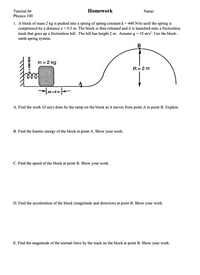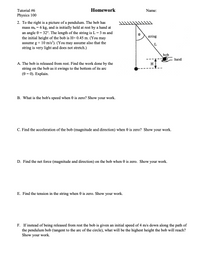Question
Could anyone help me with my physics homework?

Transcribed Image Text:**Tutorial #6 - Homework**
**Physics 100**
1. A block of mass 2 kg is pushed into a spring of spring constant \( k = 448 \, \text{N/m} \) until the spring is compressed by a distance \( x = 0.5 \, \text{m} \). The block is then released and is launched onto a frictionless track that goes up a frictionless hill. The hill has a height of 2 m. Assume \( g = 10 \, \text{m/s}^2 \). Use the block-earth-spring system.
**Diagram Explanation:**
- There is a block with a mass of 2 kg compressed against a spring.
- The block is initially at point A and moves up to point B as it travels over a hill.
- The spring is compressed by 0.5 m.
- The height of the hill is 2 m, and it forms part of a frictionless path.
**Questions:**
A. Find the work (if any) done by the ramp on the block as it moves from point A to point B. Explain.
B. Find the kinetic energy of the block at point A. Show your work.
C. Find the speed of the block at point B. Show your work.
D. Find the acceleration of the block (magnitude and direction) at point B. Show your work.
E. Find the magnitude of the normal force by the track on the block at point B. Show your work.

Transcribed Image Text:**Tutorial #6 Homework**
*Physics 100*
**2.** To the right is a picture of a pendulum. The bob has mass \( m_b = 6 \, \text{kg} \), and is initially held at rest by a hand at an angle \( \theta = 32^\circ \). The length of the string is \( L = 3 \, \text{m} \) and the initial height of the bob is \( H = 0.45 \, \text{m} \). (You may assume \( g = 10 \, \text{m/s}^2 \)). (You may assume also that the string is very light and does not stretch.)
- **Diagram Explanation:**
- The diagram shows a pendulum with a bob suspended from a fixed point by a string. The string makes an angle \( \theta \) with the vertical. The hand holding the bob is visible at one end of the string, and the initial height \( H \) is the vertical distance from the bob's starting position to its lowest point.
**A.** The bob is released from rest. Find the work done by the string on the bob as it swings to the bottom of its arc (\(\theta = 0\)). Explain.
**B.** What is the bob's speed when \(\theta\) is zero? Show your work.
**C.** Find the acceleration of the bob (magnitude and direction) when \(\theta\) is zero. Show your work.
**D.** Find the net force (magnitude and direction) on the bob when \(\theta\) is zero. Show your work.
**E.** Find the tension in the string when \(\theta\) is zero. Show your work.
**F.** If instead of being released from rest the bob is given an initial speed of 4 m/s down along the path of the pendulum bob (tangent to the arc of the circle), what will be the highest height the bob will reach? Show your work.
Expert Solution
This question has been solved!
Explore an expertly crafted, step-by-step solution for a thorough understanding of key concepts.
This is a popular solution
Trending nowThis is a popular solution!
Step by stepSolved in 8 steps

Knowledge Booster
Similar questions
- The class I'm taking is physics for scientists and engineers! I am completely stuck. Need help. I have attached the problem. If you can please explain your answer so I can fully understand. Thank you!arrow_forwardHello, Can someone please solve this problem? I am having trouble. Thank you so mucharrow_forwardHello, I was trying to solve just the first three. Thank you very much!arrow_forward
- Can someone please help me with all of the questions? I'm struggling with all of them and don't know how to solve them. Please help me!arrow_forwardI am working on some physics homework and am stuck on this one. Any help would be great, thanks!arrow_forwardplz answer g,h,i part of question number 11.arrow_forward
arrow_back_ios
SEE MORE QUESTIONS
arrow_forward_ios